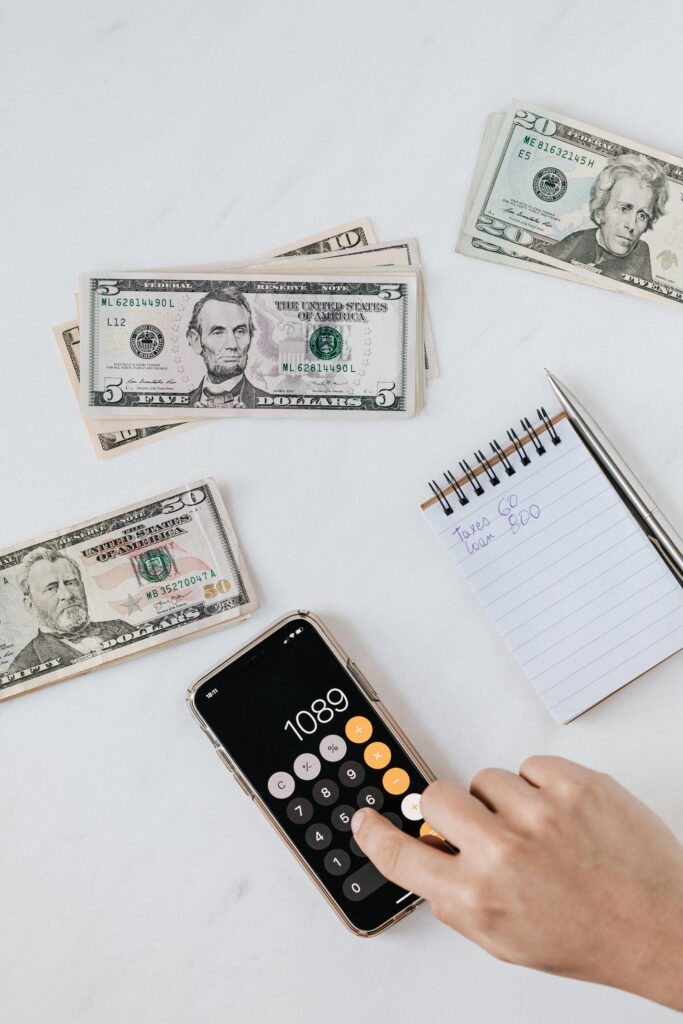10 Better Money Habits You Need To Start Doing ASAP

Look, I’m not here to sugarcoat things. Your bank account probably looks sadder than you’d like to admit, and no, it’s not entirely your fault, but it’s definitely not NOT your fault either.
Here’s the thing: making money is hard, but keeping it? That’s where most of us completely mess up.
After years of watching my own finances yo-yo between “doing okay” and “eating ramen again,”
I finally figured out what separates people who build wealth from those who wonder where their paycheck disappeared every month.
Spoiler alert: it’s not about earning six figures. It’s about what you do with whatever you’re making right now.
So buckle up, because we’re about to talk about the money habits that actually matter, the ones that’ll transform your financial life, whether you’re making $30K or $300K a year.
What Are Better Money Habits?
Think of better money habits as your financial autopilot system.
They’re the automatic behaviours and choices you make that either build your wealth or drain it faster than a phone battery on 1%.
These aren’t just random tips your financially stable friend tosses around at brunch.
Better money habits are the intentional actions you take consistently to manage your cash flow, protect your earnings, and actually make progress toward financial security.
They’re the difference between saying “I’ll figure it out” and actually having a system that works.
Here’s what I’ve learned from experience: your money habits reveal your financial future.
Show me someone who checks their bank balance regularly, tracks expenses, and makes spending decisions based on actual numbers rather than vibes.
I’ll show you someone who’s going to be just fine financially. The math really is that simple.
How Can I Improve My Money Habits?
Improving your money habits starts with brutal honesty. You need to look at where your money actually goes, not where you think it goes.
Trust me, there’s usually a huge gap between the two.
Start by examining your last three months of spending. Pull up your bank statements, credit card bills, and every receipt you can find.
Yeah, it’s tedious, but this reality check is essential. You might discover you’re spending $200 monthly on subscriptions you forgot existed or dropping $500 on takeout when you swore you were “cooking more.”
Once you understand your cash flow patterns, the improvement becomes straightforward.
You make deliberate decisions about what changes. Maybe you redirect that $200 in forgotten subscriptions into a high-yield savings account.
Perhaps your meal prep on Sundays to cut that takeout habit in half.
The key is creating systems, not relying on willpower. Willpower is exhausted by Tuesday.
Systems run automatically whether you’re motivated or not. Set up automatic transfers to savings on payday.
Use budgeting apps like Mint or YNAB that track everything for you.
Make the right choice, the easy choice.
Why Is It Important To Have Good Money Habits?
Because money doesn’t stick around just because you earned it.
I’ve seen people make $100K annually and still live paycheck to paycheck because their spending habits were a complete disaster.
Good money habits protect you from yourself.
They’re your defense against impulse purchases, lifestyle inflation, and the constant pressure to “keep up” with everyone’s Instagram highlight reel.
Without solid habits, you’re basically trying to fill a bucket with holes in it; no matter how much water you pour in, it’s all draining out.
Here’s the reality check nobody wants to hear: financial emergencies happen to everyone. Your car will break down.
Medical bills will surprise you. Your company might downsize.
The people who survive these situations without spiralling into debt?
They’re the ones with emergency funds, low debt loads, and spending habits that don’t require their absolute maximum income every single month.
FYI, building wealth isn’t s#xy. It’s boring. It’s consistently making the unsexy choice to save and invest instead of upgrading and splurging.
But that boredom? It’s what financial security actually looks like.
How To Develop Good Money Habits
Developing good money habits requires starting with a clear financial snapshot. Before you change anything, you need baseline data.
What’s your monthly income after taxes? What are your fixed expenses, rent, utilities, insurance, and minimum debt payments?
What’s left over, and where does it currently go?
Grab a notebook or open a spreadsheet. Track every single expense for 30 days. And I mean everything, that $3 coffee, the $15 impulse buy at Target, the $8 parking fee.
This exercise sounds painful because it is, but it’s also incredibly revealing.
Once you have this data, identify your financial leaks. These are expenses that don’t align with your actual values or goals.
Maybe you’re paying $60 monthly for a gym membership you’ve used twice this year.
Perhaps you’re dropping $150 on streaming services when you really only watch two shows.
Next, implement one new habit at a time. Trying to overhaul everything simultaneously is like starting a diet by going straight to eating only kale smoothies; you’ll crash within a week.
Pick one habit, make it stick for 30 days, then add another.
Use tools that automate good behaviour. Apps like Acorns round up your purchases and invest the difference.
Qapital lets you set rules that automatically save money based on triggers you choose.
Technology should make good habits easier, not harder.
Benefits Of Good Money Habits
The benefits of solid money habits extend way beyond just having a bigger bank balance, though that’s definitely a nice perk.
Financial stress drops dramatically. When you have good money habits, you stop living in that constant low-level panic about whether you can afford your bills.
You know where your money is going because you’re directing it intentionally.
That mental peace is worth more than most people realize.
Opportunities become accessible. Want to start a business? Switch careers? Move to a new city?
Good money habits create the financial cushion that makes these moves possible.
You’re not trapped by debt or lack of savings. You have options, and options equal freedom.
Here are the concrete benefits you’ll experience:
- Debt elimination becomes achievable: When you control your spending and redirect money toward debt payoff, you actually make progress instead of just treading water on minimum payments
- Financial goals transform from dreams to plans: That house down payment, early retirement, or fully funded college savings account stops being a fantasy and becomes a timeline with actual milestones.
- Your money works harder – Even modest income goes further when you’re not haemorrhaging cash on fees, interest charges, and impulse purchases.
- You build real wealth – Compound interest becomes your friend instead of your enemy when you’re investing regularly rather than paying it on debt.
- Financial literacy becomes second nature – Good habits teach you how money actually works, which creates a positive feedback loop of better decisions.
The compounding effect is real. One good money habit makes the next one easier.
They build on each other until managing money well becomes your default mode instead of something you have to consciously think about.
10 Good Money Habits
Alright, let’s get into the specific habits that’ll actually move the needle on your finances.
These aren’t theoretical; they’re the practical behaviors that separate people who build wealth from those who wonder where it all went.
1. Create A Budget

I know, I know. The word “budget” makes most people want to immediately scroll past this section.
But hear me out, budgeting isn’t about restriction. It’s about permission.
A budget tells your money where to go instead of wondering where it went.
Without one, you’re essentially driving blindfolded and hoping you don’t crash.
With one, you’re in control, making intentional choices about what matters to you.
Here’s my approach: after your paycheck hits your account, assign every dollar a job before you spend anything.
Housing gets its share, food gets its allocation, savings gets its cut, and entertainment gets a budget too. Nothing gets spent without a category.
Start with the 50/30/20 rule if you need a framework: 50% for needs, 30% for wants, 20% for savings and debt repayment.
Adjust these percentages based on your situation, but the framework gives you a starting point.
Use budgeting tools that sync with your accounts automatically.
PocketGuard shows you how much you have left to spend after bills and goals.
EveryDollar uses zero-based budgeting to assign every dollar. Find what works for your brain and stick with it.
The biggest budgeting mistake? Making it so restrictive that you can’t maintain it.
Build in flexibility. Include fun money. Just make sure it’s an intentional amount, not whatever’s left after random spending.
2. Clear Your Debt
Debt is like a financial anchor dragging you backwards while you’re trying to swim forward. You can make progress, but man, it’s exhausting and slow.
I’m not going to pretend all debt is terrible; mortgage debt and some student loans can be strategic.
But credit card debt at 22% interest? Car loans that cost more than the vehicle’s worth? That’s destroying your financial future every month.
Pick a debt repayment strategy and commit to it. The debt avalanche method attacks the highest-interest debt first, saving you the most money mathematically.
The debt snowball method pays off the smallest balances first, giving you psychological wins that keep you motivated.
Honestly? The one you’ll actually stick with is the right one.
Consider this: every dollar you’re paying in interest is a dollar that can’t build wealth for you.
If you’re paying $300 monthly in credit card interest alone, that’s $3,600 annually that could be going into investments earning compound returns instead.
Boost your debt payments by finding extra money in your budget or increasing your income through side hustles.
Even an extra $100 monthly toward debt can shave years off your repayment timeline and save thousands in interest.
Call your creditors and negotiate lower interest rates. Seriously, this works more often than you’d think.
Tell them you’re considering balance transfer offers, which often motivates them to work with you.
3. Save Before You Spend

This habit changed everything for me. Instead of saving whatever’s left at month’s end (spoiler: there’s never anything left), I started treating savings like a non-negotiable bill.
The strategy is simple: as soon as your paycheck hits, automatically transfer your savings percentage to a separate account.
What’s left in your checking account is what you have to spend.
This is called “paying yourself first,” and it’s how people who “aren’t good with money” somehow end up with healthy savings accounts.
Set up automatic transfers on payday. If you get paid on the 1st and 15th, schedule transfers for those dates.
Even 5% is better than 0%. Start where you can, then increase gradually as you adjust to living on slightly less.
Open a high-yield savings account separate from your checking account.
Marcus by Goldman Sachs, Ally Bank, and American Express Personal Savings offer rates significantly higher than traditional banks.
The physical separation reduces temptation to dip into savings for non-emergencies.
Build toward saving 20% of your gross income if possible.
That might sound insane right now, but remember, you got here through incremental increases, not an overnight transformation.
4. Avoid Irrelevant Expenses
IMO, this is where most people completely sabotage their finances without realising it. Those “small” purchases add up faster than you think.
Irrelevant expenses are things you buy that don’t actually improve your life or align with your values.
That decorative bowl you bought at Target because it was cute, but you have never used. Irrelevant.
The third streaming service you forget you’re paying for? Irrelevant.
The takeout you ordered because cooking felt like too much effort, not because you actually craved it? Probably irrelevant.
The solution isn’t to never spend money on anything fun.
The solution is to spend intentionally on things you actually value and eliminate the autopilot spending on stuff that doesn’t matter to you.
Try this exercise: before any non-essential purchase, wait 48 hours. If you still want it after two days, and it fits your budget, go for it.
You’ll be shocked at how many “must-have” items you completely forget about once that initial impulse passes.
Cancel subscriptions you’re not actively using. Review your bank statement right now and highlight every recurring charge.
Be honest about what you actually use versus what you “might use someday.”
That $10 monthly charge you barely notice. That’s $120 annually that could be working for you instead.
Cut back on convenience spending.
Those small convenience purchases, bottled water instead of using a reusable bottle, parking in the premium lot instead of walking an extra five minutes, grabbing coffee out instead of making it, they’re death by a thousand cuts to your budget.
5. Invest
Saving money is crucial, but it’s only half the equation. If your money is just sitting in a checking account earning 0.01% interest, you’re actually losing money to inflation every year.
Investing puts your money to work generating returns while you sleep. That’s how wealth actually builds, through compound growth over time, not through trying to save every penny in a zero-interest account.
Start with your employer’s 401(k) if they offer one, especially if there’s a company match.
That match is literally free money. Not taking advantage of it is like declining part of your salary.
Contribute at least enough to get the full match, then increase your contribution percentage by 1% every time you get a raise.
Open an IRA (Individual Retirement Account) for additional tax-advantaged investing.
Roth IRAs are particularly powerful if you’re early in your career, you pay taxes now when your rate is lower, then withdraw tax-free in retirement.
Use platforms like Vanguard, Fidelity, or Charles Schwab that offer low-cost index funds.
Can’t afford much? Start with micro-investing apps like Acorns or Stash that let you invest spare change. The amount matters less than building the habit of regular investing.
Diversify through low-cost index funds rather than picking individual stocks. Index funds spread risk across hundreds of companies, reducing the chance that one bad performer tanks your portfolio.
Target-date retirement funds automatically adjust your risk level as you age, making them perfect for hands-off investors.
The biggest investing mistake? Waiting until you feel “ready” or have a “decent amount” to start.
Start now with whatever you can afford. Time in the market beats timing the market every single time.
6. Track Your Spending

You can’t manage what you don’t measure. Tracking spending sounds tedious until you realise it’s the only way to know if your financial plan is actually working or just theoretical.
Modern technology makes this painless. Apps like Mint automatically categorise transactions, showing you exactly where your money goes each month.
Personal Capital gives you a complete financial picture, including investments.
Simplifi by Quicken offers customizable spending plans with real-time updates.
Review your spending weekly, not monthly. Monthly reviews come too late; you’ve already overspent by the time you notice.
Weekly check-ins let you course-correct before small problems become big ones.
Look for patterns in your spending data. Maybe you consistently overspend on weekends, or perhaps dining out spikes when you’re stressed.
Identifying these patterns helps you implement preventive strategies rather than just reacting to overspending after it happens.
Compare your actual spending to your budget categories. Are you consistently over in certain areas?
Time to either adjust your budget to reality or adjust your behaviour to match your goals.
Both are valid options depending on what matters to you.
Use your spending data to make smarter financial decisions.
Maybe you discover you’re spending $400 monthly on groceries but wasting $100 worth of food.
That insight allows you to adjust shopping habits and redirect that $100 toward something more valuable to you.
7. Have A Side Hustle
Sometimes managing money better isn’t enough; you need more money to manage. That’s where side income becomes a game-changer.
A side hustle doesn’t have to be a second full-time job. It’s any additional income stream beyond your primary employment.
This could be freelancing, consulting, selling products online, driving for rideshare services, tutoring, or any number of options.
The beauty of side hustle income is that you can direct it entirely toward financial goals since your primary income already covers living expenses.
That extra $500 monthly from freelancing? That’s $6,000 annually toward debt payoff, emergency fund building, or investment contributions.
Choose a side hustle that leverages skills you already have. If you’re good at writing, try content creation or freelance writing on platforms like Upwork or Fiverr.
If you’re handy, offer home repair services through TaskRabbit. If you’re organised, become a virtual assistant.
Start small and scale gradually. Don’t quit your day job to pursue a side hustle that hasn’t proven itself.
Begin with a few hours weekly, validate there’s demand and you can deliver quality work, then expand as it makes sense.
The additional income creates financial breathing room. Suddenly, you’re not living quite so tight. You can handle unexpected expenses without panic.
You’re making real progress on financial goals instead of just hoping things improve somehow.
8. Create Assets, Not Liabilities
This is where people either build wealth or stay broke while looking successful.
Understanding the difference between assets and liabilities determines your financial trajectory.
An asset puts money in your pocket. A liability takes money out. Your primary residence?
Unless you’re renting rooms, it’s a liability; yet it costs you money in mortgage, maintenance, insurance, and taxes.
Investment properties generating rental income? Those are assets. Your car? Liability. A side business generating profit? Asset.
The wealthy focus on acquiring assets. The broke focus on acquiring liabilities while calling them assets because they’re expensive.
A $60,000 truck might feel like wealth, but it’s draining thousands annually in payments, insurance, gas, and depreciation.
Invest in income-generating assets: dividend-paying stocks, rental properties, businesses, bonds, REITs (Real Estate Investment Trusts).
These assets generate cash flow while (hopefully) appreciating over time.
Minimise liabilities ruthlessly. You don’t need the newest car; a reliable used vehicle does the job while costing less.
You don’t need the biggest house; something appropriately sized costs less in every category.
Every dollar you’re not spending on liabilities is a dollar available to purchase assets.
That spread is literally the difference between building wealth and staying on the hamster wheel.
Think about purchases differently. Before buying something expensive, ask: “Will this generate income or cost me money over time?”
If it costs money, you need a really good reason beyond “I want it” or “I deserve it.”
9. Plan For Big Purchases
Big purchases require strategy, not just hope and a credit card. Planning for major expenses is how you avoid debt and buyer’s remorse.
Define what constitutes a “big purchase” for your situation.
Maybe it’s anything over $500, or perhaps your threshold is $1,000. Whatever the amount, it triggers your planning process.
Set a specific savings timeline. Want a $3,000 laptop in six months? That’s $500 monthly.
Want a $15,000 used car in 18 months? That’s about $835 monthly.
Breaking big numbers into monthly chunks makes them feel achievable instead of impossible.
Open a separate savings account specifically for big purchase goals.
Name it something specific, “Car Fund” or “Vacation Savings”, so you’re not tempted to raid it for random expenses.
Ally Bank and Capital One let you create multiple savings accounts with custom names, making this easy.
Research thoroughly before buying. Read reviews, compare options, check for upcoming sales or newer models that might drop the price on what you want.
Rushed purchases usually result in buyer’s remorse or overpaying.
Consider the total cost of ownership, not just the purchase price. That $500 discount on a car doesn’t matter if it gets worse gas mileage, has higher insurance costs, and needs more repairs.
Look at the complete financial picture over the item’s lifespan.
Avoid financing big purchases unless necessary. If you must finance, ensure the monthly payment fits comfortably in your budget without sacrificing other financial priorities.
A payment that’s “technically affordable” but requires cutting retirement contributions isn’t actually affordable.
10. Shop With A List
Shopping with a list sounds stupidly simple, but it’s one of the most effective ways to prevent overspending.
The grocery store is designed to make you buy things you didn’t plan to buy. That’s literally the entire business model of retail. Endcaps feature impulse purchases.
Checkout lanes are lined with snacks. Sales signs create urgency for items you weren’t even considering.
A shopping list is your defence against marketing psychology.
Before going to any store, grocery, Target, Home Depot, wherever, write down exactly what you need. Then buy only what’s on the list. Period.
Include quantities on your list to prevent overbuying based on sales. “3 cans of tomatoes” is more effective than just “tomatoes” when you encounter a sale that makes you think you should stock up.
Meal plan before grocery shopping so your list aligns with actual needs.
Planning a week of meals means your grocery list covers real upcoming meals, not just vague ingredients you hope will somehow become dinner.
Use pickup or delivery services if you struggle with in-store impulse control. Ordering online makes it easier to stick to your list since you’re not walking past temptations.
Many stores offer free pickup, making this a zero-cost solution.
Give yourself a small “fun money” allowance for impulse purchases.
If you know you can grab one treat item, you’re more likely to stick to the list overall. Complete restriction usually backfires.
Track how much you save by shopping with a list. Compare receipts from planned shopping trips versus random ones. The difference will probably shock you and reinforce the habit.
Final Thoughts
Better money habits aren’t about deprivation, they’re about intention. You’ll slip up, overspend, or forget to track expenses sometimes.
That’s not failure, it’s being human. The real difference between those who build financial security and those who don’t is persistence; they get back on track instead of giving up.
Focus on one habit at a time. Master it over 30 days before adding another.
Trying to fix everything at once leads to burnout.
Small, consistent actions might not feel powerful, but over time, they compound into life-changing results; that’s math, not motivation.
You’ve got this. Not because it’s easy, but because you can choose differently, one intentional action at a time.
So, pick one habit now. Open that budgeting app, set that transfer, or make that list.
Your future self will thank you for starting today, not “someday.”








